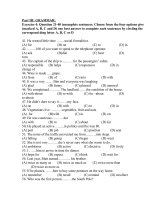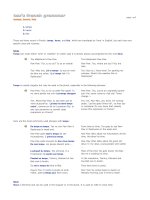Modern FRENCH Grammar pptx
Bạn đang xem bản rút gọn của tài liệu. Xem và tải ngay bản đầy đủ của tài liệu tại đây (1.97 MB, 387 trang )
Modern FRENCH Grammar
Second Edition
Routledge Modern Grammars
Series concept and development—Sarah Butler
Other books in series:
Modern German Grammar, Second EditionModern German Grammar
Workbook, Second Edition
Modern Italian Grammar
Modern Italian Grammar Workbook
Modern Spanish Grammar, Second EditionModern Spanish Grammar
Workbook, Second Edition
Modern FRENCH Grammar
A practical guide
Second Edition
Margaret Lang
and Isabelle Perez
LONDON AND NEW YORK
First published 1996
by Routledge
Reprinted 1997, 2000, 2002 (twice), 2003
Second edition published 2004
by Routledge
11 New Fetter Lane, London EC4P 4EE
Simultaneously published in the USA and Canada
by Routledge
29 West 35th Street, New York, NY 10001
Routledge is an imprint of the Taylor & Francis Group
This edition published in the Taylor & Francis e-Library, 2005.
“To purchase your own copy of this or any of Taylor & Francis or Routledge’s collection of
thousands of eBooks please go to www.eBookstore.tandf.co.uk.”
© 1996, 2004 Margaret Lang and Isabelle Perez
All rights reserved. No part of this book may be reprinted or reproduced or
utilised in any form or by any electronic, mechanical, or other means, now
known or hereafter invented, including photocopying and recording, or in
any information storage or retrieval system, without permission in writing
from the publishers.
British Library Cataloguing in Publication Data
A catalogue record for this book is available from the British Library
Library of Congress Cataloging in Publication Data
Lang, Margaret, 1940–
Modern French grammar : a practicle guide/Margaret Lang and Isabelle Perez.—2nd ed.
p. cm. —(Routledge modern grammars)
Includes index.
1. French language—Grammar. 2. French language—Textbook for foreign speakers—English.
I. Perez, Isabelle, 1962–. II. Title. III. Series.
PC2112.L35 2004
448.2′421–dc22 2003026062
ISBN 0-203-39725-8 Master e-book ISBN
ISBN 0-203-67129-5 (Adobe eReader Format)
ISBN 0-415-33482-9 (hbk)
0-415-33162-5 (pbk)
Contents
Acknowledgements xi
Introduction xii
How to use this book xvii
Glossary xix
SECTION A Structures
I The noun group 2
1 Articles 2
2 The definite article 2
3 The indefinite article 9
4 The partitive article 11
5 Demonstrative adjectives 15
6 Demonstrative pronouns 17
7 Possessive adjectives 20
8 Possessive pronouns 22
9 Nouns 23
10 Adjectives 31
11 Indefinite adjectives, pronouns and adverbs 40
12 Personal pronouns 51
13 Reflexive pronouns 56
14 Emphatic pronouns; position and order of pronouns 56
15 Relative pronouns 62
16 Interrogative pronouns, adjectives and adverbs 67
17 Cardinal and ordinal numbers 72
18 Fractions 77
19 Approximate quantities 78
20 Dimensions 78
21 Adverbs of quantity 80
II The verb group 82
22 Agreement of verb and subject 82
23 Formation of tenses 86
24 The indicative tenses; the present tense 86
25 The future tense 93
26 The imperfect tense 97
27 The past historic 100
28 The compound tenses 103
29 How the perfect is used 104
30 How the future perfect is used 107
31 How the pluperfect is used 108
32 How the past anterior is used 109
33 The conditional and the conditional perfect 110
34 The subjunctive 114
35 The present subjunctive 114
36 The imperfect subjunctive 116
37 The perfect subjunctive 117
38 The pluperfect subjunctive 117
39 Sequence of tenses; uses of the subjunctive 117
40 Reflexive verbs 127
41 The passive 129
42 The past participle 132
43 The present participle 137
44 The imperative 139
45 The infinitive 142
vi
46 Impersonal verbs 145
47 Adverbs 147
48 Prepositions 156
SECTION B Functions
III Exposition 159
49 Referring to people, things and places 159
49.1 Physical characteristics 159
49.2 Personality 161
49.3 Relationships 162
49.4 Age 165
49.5 Ownership 167
49.6 Dimensions 172
49.7 Quantity and number 174
49.8 Quality 179
49.9 Comparison 180
49.10 Directions 184
49.11 Location 187
49.12 Manner 191
50 Narrating 194
50.1 Present time 195
50.2 Past time 197
50.3 Future time 200
50.4 Dates and time 201
50.5 Sequence 205
51 Reporting 208
52 Asking questions 215
53 Negating 219
IV Attitude 222
54 Greeting and leave-taking 222
vii
54.1 Greeting 222
54.2 Leave-taking 223
55 Expressing congratulations and appreciation 225
55.1 Congratulations 225
55.2 Appreciation 226
56 Expressing apologies and sympathy 228
56.1 Apologies 228
56.2 Sympathy 230
57 Expressing surprise and disgust 232
57.1 Surprise 232
57.2 Disgust 234
58 Expressing contrasting attitudes, emotions, feelings 235
58.1 Likes and dislikes 235
58.2 Preference 237
59 Love and hate 238
60 Enthusiasm and indifference 240
61 Hopes, fears and regrets 241
62 Approval and disapproval 243
V Argumentation 245
63 Agreeing and disagreeing 245
63.1 Agreeing 245
63.2 Disagreeing 247
63.3 Agreeing to differ 250
64 Asserting and confirming 251
64.1 Asserting 251
64.2 Confirming 252
65 Admitting and conceding 253
65.1 Admitting 253
65.2 Conceding 254
viii
66 Correcting and protesting 255
67 Contradicting and criticizing 258
68 Suggesting and persuading 260
68.1 Suggesting 260
68.2 Persuading someone to think the way you do 262
68.3 Persuading someone to do/not to do something 264
68.4 Other ways of persuading and dissuading 264
69 Expressing volition 267
69.1 Verbs expressing volition 268
69.2 Wishing and intending 269
69.3 Asking what someone intends 270
69.4 Asking someone for something 272
69.5 Expressing (un)willingness to act upon request 273
69.6 Deliberate or non-deliberate actions 275
69.7 Saying what you do not want 276
70 Expressing permission and obligation 278
70.1 Permission 278
70.2 Prohibition 279
70.3 Obligation 281
70.4 Exemption 285
71 Expressing doubt and certainty 287
71.1 Doubt and certainty 287
71.2 Possibility and probability 292
71.3 Condition and hypothesis 298
72 Expressing logical relations 302
72.1 Cause—explicit 302
72.2 Cause—implicit 306
72.3 Consequence—explicit 307
72.4 Consequence—implicit 311
ix
72.5 Aim 312
73 Expressing opposition 315
74 Structuring 321
74.1 Beginning 321
74.2 Continuing 326
74.3 Ending 328
VI The sounds of French 333
75 Vowels 333
76 Nasal vowels 333
77 Semi-vowels/semi-consonants 333
78 Consonants 334
79 Accents, cedilla, diaeresis 334
80 Liaison 335
81 Elision 337
Verb tables 339
Index of grammar structures and functions 354
x
Acknowledgements
The authors would like to thank the following for their permission to reproduce
extracts from copyright material: Grasset, Paris, Roger Vailland, Un Jeune
Homme Seul, 1951 (p. 77) Le Monde 23.3.95 and 17.9.03 (pp. 83, 88); Plon,
Paris, for H.Troyat, Grandeur Nature, 1936 (p. 86); The Guardian 16.2.95 (p.
104); M.Noailles for G. Moustaki, ‘Le Métèque’ (p. 134); Editions La
Découverte, collection Repères, Paris, for J.Vallin, La Population française,
1989 (p. 139); Documentation européenne for P.Fontaine, ‘Les Grandes Phases
historiques’ in Dix Leçons sur l’Europe, 1992 (p. 164); Journal Officiel des
Communarités Européennes for Débats du Parlement européen 15.2.90 (p. 205);
Capital, August 1994 (p. 245).
Introduction
This book is designed to provide the essential elements of French grammar, for
students in the final year of school and in the first and later years of higher
education. Advanced learners will find much that is useful for extending their
knowledge of French, and for revision. The book is organized in two major
sections: a reference section containing the structures of grammar and a section
containing functional grammar. Each section includes cross-references to the
other.
The reference grammar, which is as comprehensive as possible, has been
structured around the noun phrase—dealing with all the elements related to the
noun: articles, pronouns, adjectives and numbers—and the verb phrase—dealing
with all the elements related to the verb: tenses, mood, participles and adverbs.
The functional grammar is composed of three parts, each demonstrating how
to do things with language in order to communicate. The three principal
functions identified are exposition, attitude and argumentation. Each of these is
divided into smaller function areas related to the principal function.
The functions
Exposition
Communication involves both giving and obtaining information: we make
statements and we ask questions about someone or something. This involves
(a) referring to people, things and places
(b) narrating events in some sort of sequence
(c) reporting what we or other people say or think.
In other words, we are giving or obtaining information about who, what, when,
how, where and why. Exposition includes three groups of functions identified,
very broadly, as referring, narrating and reporting.
Referring to people, things and places involves giving and obtaining
information about physical characteristics, personality, relationships, age,
ownership dimensions, quantity and number, quality or distinguishing
characteristics, comparison, direction, location and manner.
Narrating involves talking about events or actions in terms of present, past and
future time, dates and time, and sequence. Reporting describes what we or other
people say and write. Reporting is usually clearly indicated by the presence of an
introductory verb. There are many verbs which can introduce reported speech of
which the commonest is ‘say’. Some of the others are ‘think, remind, ask; hope,
believe, want, suggest, answer, admit, forget’. Interrogative structures are
included in this section because we need to know how to obtain information, and
to do this we ask questions, and negation is included because, of course, sometimes
we need to say that something is not the case.
Attitude
Expressing an attitude towards someone or something usually means that we are
introducing a personal, subjective element into communication: we are indicating
our reaction to someone or something, we are evaluating, and making judgements
—in a non-detached way. And we may do so spontaneously or intentionally.
Closely related to attitudes are the emotions and feelings which most of us
experience and express from time to time. These, too, are personal and
subjective, and, on occasion, they may in fact be attitudes. The focus of this
section is, then, on the communication of attitudes, emotions and feelings and
how we express them. We look first at the ways in which we greet or take leave
of people when we are speaking or writing to them. Then we turn to the ways in
which we express congratulations and appreciation, apologies and sympathy,
and surprise and disgust. Finally, we consider ways in which we express
contrasting attitudes, emotions and feelings: likes, dislikes and preference, love
and hate, enthusiasm and indifference, hopes and fears, approval and disapproval.
Argumentation
Effective communication usually requires a certain amount of planning, and this
involves the need to
(a) structure what we want to say or write
(b) determine the best strategies to employ
(c) select the means of expression most suited to the structure, to the strategies,
and, above all, to a specific context or situation.
The structure is the plan in what we are saying or writing, the strategy is the
function we are employing, and the means of expression is the grammatical or
lexical structure (for example, verb construction, noun phrase) which is most
appropriate for the plan and the function.
xiii
It may be that a single word is enough to achieve what we want, but more
frequently we are involved in a discussion or explaining something or arguing a
case and so on. Often, there is simply not enough time to plan carefully what we
want to say— though there is more time when we are writing. Also, it would be
virtually impossible to try to learn every function and every means of expression.
However, if we are familiar with some kinds of plan, with various types of
function, and with some of the means for expressing them, then we can not only
use them ourselves, but recognize them when we are listening to or reading what
other people are saying or writing.
There are many kinds of plan in what is said and written, and these plans vary
in complexity. Examples of plans, or planning, are the following:
(a) creating a clear overall structure with an introduction, middle section and
conclusion
(b) listing a series of points
(c) putting another point of view and defending it
(d) proceeding from cause to effect, or vice versa.
In some situations, parts of plans may be enough and indeed appropriate for
achieving what we want, for example, only part of (c). At other times we may
need to put into action a fully developed plan, for example, a combination of (a)–
(d). Finally, we must remember that there is no single, perfect plan suitable for
every situation or context.
The functions available to us when we want to achieve something in
argumentation are many. We may, for example, want to agree, indicate doubt,
reject, criticize. We may wish to emphasize, persuade, influence, express
obligation. Whatever it may be, whether we are initiating a discussion, making a
speech, contributing to a conversation, reacting to a comment, broadcast or
report, we have at our disposal a wide range of possible moves. We cannot, of
course, know how someone is going to react to what we are saying or writing, so
we need to have access to a range of responses in order to adapt to an unforeseen
reaction, and respond appropriately.
The section on argumentation provides a comprehensive range of functions—
and the means of expressing them—which are in fairly common use. You will
recognize them when people are speaking and writing. It is recommended that
you try to put them into practice in speech and writing whenever appropriate.
The functions are presented as follows—agreeing and disagreeing, asserting and
confirming, admitting and conceding, correcting and protesting, contradicting
and criticizing, suggesting and persuading, expressing volition, permission and
obligation, doubt and certainty, logical relations, opposition, and structuring.
xiv
The examples
The examples in the reference section are simple illustrations of the grammar
structure in question. In the functional section the examples are selected from
contemporary spoken and written French to demonstrate the function in
question. They are actual examples which have been used in our own
experience, and they are quoted within as much context as possible to illustrate
the function and the related grammar structure.
The translations
The examples in both the reference and the functional sections are translated into
English. In the reference section, translations are kept as close as possible to the
French, in the functional section, on the other hand, where there is usually a
substantial amount of context, the English equivalent is provided, rather than a
direct and possibly, therefore, stilted version of the original.
Forms and functions
The forms in any living language are flexible and changing. At any one time they
can vary according to the individual speaker or writer, to the part of the country
he/she comes from or lives in, and indeed to fashion. There is seldom only one way
of saying or writing something, and not very often a one-to-one equivalence of
form and function.
This is clearly illustrated in the section on the imperative (A.44) where this
one grammar structure is shown to have a variety of functions: the imperative
form can be used to express an order, an instruction, an invitation, etc. It is also
illustrated in the many functions of each of the tenses. Similarly, in the
functional section, many forms are suggested for expressing one function: giving
directions (B.49.10), for example, can be expressed through the imperative, the
future tense, a combination of the two, etc.
Just as there is a network of relations between forms and functions, so there is
a network of functions related to each single function. Agreeing (B.63.1), for
example, is naturally associated with its opposite—disagreeing (B.63.2), and
then also with a combination of the two—agreeing to differ (B.63.3)
Register
Register refers by and large to the different vocabulary and grammar structures
we use when we are talking or writing to different people, and the levels of
formality and informality we use. For example, we would be more formal with a
teacher, a doctor, a policeman, at an interview…, but fairly informal with
members of our family, friends or when simply chatting. We usually take into
xv
account the status, age, and the relationship we have with other people, and the
situation we are in, and we automatically adjust our language to them.
At times, we switch from formality to informality, when, for example, we
begin to feel more comfortable with a person, or from informality to formality if,
for example, a conversation with our bank manager switches from friendly
conversation to a request for an increase in a loan.
What we are doing is quite normal and acceptable and is simply adapting to a
situation.
In the grammar it is not possible to cover the wide range of levels that exist
between formality and informality, but we have indicated in the examples where
the register is formal or informal. Otherwise, examples should be taken as
standard register—the register used by an average, educated speaker or writer.
Don’t you want to take them round all the museums?
Tu veux pas les balader dans tous les musées? (informal)
Voulez-vous leur faire visiter tous les musées? (formal)
xvi
How to use this book
This book brings together two sets of guidelines on the French language:
A—A reference grammar covering the major points which need to be
mastered so that you get things right.
B—A functional grammar covering the major types of communication
you may want or need to carry out.
At your disposal, then, you have the essentials of grammar (section A) and
applications of the grammar in a wide selection of functions (section B). When
we were preparing this book, we kept in mind the frequent changes which any
living language undergoes, and we have, therefore, included comments on
exceptions to the guidelines. And, wherever appropriate, we have included
informal ways of saying or writing something. The majority of examples have
cross-references to information concerning one or more grammar points or
concerning additional details on the function.
How, then, will you use the book? If, for example, you want to greet someone
you look up B.54.1. In this section you will find a number of suggestions on
different ways of saying ‘Hi!’ or ‘Good morning!’, for example. It’s not very
difficult to know how to say hello, of course, but, are you aware of the difference
between Bonjour! and Bonsoir!? On the other hand, you might want to
persuade someone to do something. To find a suitable way of doing this you look
up B.68.3 and you will again find a number of suggestions for persuading, and
cross-references to the appropriate grammar guideline. When you are looking at
the functions, we suggest that you also consider the much longer context that is
provided to see what happens to a grammatical form when it is in use.
There are other ways of saying and writing the same things—the examples
given here are only suggestions, and you are bound to come across other means
of expression the more you come into contact with French either at university or
in your professional life. We recommend that you consider the suggestions
provided here, select the form, or forms, that suit you best and learn them; when
you meet alternative ways of saying or writing something, add them to your
repertoire.
Before the verb tables we have included a section with the sounds of French,
and several words for you to practise the sounds. Your teacher will be able to
help you with them.
xviii
Glossary
Many of the terms used in this grammar are explained at the beginning of the
section in which they are used, but there are some terms which are not explained
in a specific section because they occur in several sections, and there are some
which may cause difficulty for students. The short list which follows includes the
terms which we think need special attention. We have assumed that most students
using this grammar are familiar with most of the traditional grammar terms such
as noun, verb, adjective.
Adverb
A word or phrase which gives information about how, where and/or when
something occurs. There are adverbs of manner, place, time, degree, duration
and frequency. Adverbs can modify a verb (faire avec soin), an adjective
(très difficile), or another adverb (beaucoup trop). Adverbs are always
invariable, unlike some other parts of speech, that is, they never change their
spelling to agree with another part of speech.
Antecedent
A word or group of words which precedes another word or group of words.
Relative pronouns, or words such as ce, have antecedents to which they refer
back (L’homme qui a donné un pourboire n’a pas beaucoup d’argent).
Apposition
The placing of a word or phrase directly beside another word or phrase in order
to provide more information about the other one (Jacques Chirac, Président
de la République). There is no article between the words in apposition.
Cohesion
The linking of words, phrases, sentences and paragraphs by means of cohesive
devices, which may be clauses, adverbs, pronouns, negatives, etc. (the adverbs
include et, mais, par contre, d’abord).
Complement
A word or phrase which completes the meaning of, or gives more information
about, something. The complement may be a word in apposition (see above), a
direct object (Elle a mangé la pomme), an indirect object (Il le leur a
vendu), the agent in a passive sentence (La tarte a été volée par le petit garçon)
….
Conjugation
This refers to all the endings of a verb. Verbs are usually classified according
to one of four main conjugations in French: -er, -ir, -re, -oir. Each of the
conjugations has its own set of six endings for each tense. Regular verbs have
the set of endings which belong to a particular conjugation, so grammar books
are able to give a model verb for each conjugation which all the regular verbs
of that conjugation will follow (regular -er verbs follow donner, for example).
Irregular verbs are those which do not follow either the stem or the endings of
a conjugation. The most useful irregular verbs are included in verb tables in
grammar books.
Determiners
These are words which are part of the noun group. There are many of them in
French— all the articles (le, un, du…); the possessive adjectives (mon, ton,
son…); the demonstrative adjectives (ce, cet, cette…); the interrogative and
exclamatory adjective quel (as in Quelle maison?/!); indefinite adjectives
(certain, chaque, différents, divers, maint, plusieurs, quelque, tout);
aucun, normally in the singular (Elle n’a aucun talent); the cardinal numbers
used as adjectives (as in deux journaux).
Direct and indirect objects
The direct object is a noun or pronoun referring to a person or thing directly
affected in some way by an action. The direct object is never introduced by a
preposition (Il a lu le livre) The object is indirect when it is introduced by a
preposition, usually à or de (Nous le donnons à nos parents. Ça dépend de
nos parents). Indirect object pronouns are me, te, lui, nous, vous, leur. These
pronouns are not preceded by à—it is built into the pronoun (Nous le leur
donnons). Following de, and other prepositions, the emphatic pronouns are
used (Ça dépend de toi).
Finite
Refers to the many parts of verbs which have endings. These endings indicate
whether the subject is singular or plural, the tense and the mood. The
infinitive is the part of the verb which ends in -er, -ir, -re, -oir, and in this case
there is no finite ending giving information about whether the subject is singular
or plural, or the tense.
Gender and number
These are very important grammar concepts in French. If you forget to make
adjectives agree with nouns or verbs with subjects, then you have simply made
mistakes, and that can cost you marks! Gender in French is either masculine
(le, il…), or feminine (la, elle…), and all nouns are masculine or feminine, and
adjectives have to agree with their noun. Number refers to whether a noun or
pronoun is singular (just one person, thing or action), or plural (two or more
people, things or actions). Verbs have to agree with their noun or pronoun
subject.
Impersonal verb
A verb of which the subject is il ‘it’ (il faut ‘it is necessary’). The impersonal
verb can sometimes become personal by the addition of a personal pronoun (il
me faut ‘I must’).
To modulate
To change or influence the meaning of a word or phrase in some way. There
are various ways of doing this, using nouns, adjectives, verbs or adverbs which
have specific nuances. You can also, for example, in greeting and leave-taking
—merely by altering the intonation you use—make what you say courteous or
discourteous, friendly or aggressive. A slight change of meaning is called a
nuance (of meaning). You can achieve a different nuance simply by adding, or
changing, the intonation you use.
Mood
This refers to the different forms in the conjugation of a verb which indicate the
functions for which the verb is used. So, you have the indicative mood (fact),
the subjunctive mood (non-fact); the interrogative mood (questions), the
conditional mood (conditions and hypotheses), the imperative mood (orders).
The mood of the verb can be changed according to what you want to express;
for example, fact, non-fact, questions.
xx
Transitive and intransitive verbs
Verbs can be transitive or intransitive. A transitive verb is a verb with a direct
object (Il a lu le livre). An intransitive verb does not have an object (Il travaille
bien). Verbs may be directly transitive (Il a lu le livre. Mange ta soupe) or
indirectly transitive (Pense à nous). Almost all normally transitive verbs can
be used intransitively (Il boit un verre. Il ne boit pas). And some normally
intransitive verbs can be used transitively (Il sort. Il sort sa voiture).
Abbreviations used in the grammar
f—feminine, m—masculine, s—singular, pl—plural
qn—quelqu’un, qch—quelque chose
xxi
Section A
Structures
I
The noun group
1
Articles
French has three articles: the definite article, the indefinite article and the partitive
article. They agree with nouns in gender and number. In general, they are used in
a similar way to English articles, but there are several important differences.
1.1 Forms
Definite Indefinite Partitive
Masculine singular le (l’) un du (de l’)
Feminine singular la (l’) une de la (de l’)
Plural les des des
+de/d’ +de/d’
2
The definite article
The definite articles are le, la, les ‘the’. Contracted forms are used when the
prepositions de ‘of, from’ or à ‘to’ (and sometimes ‘from’: emprunter à ‘to
borrow from’) precede the articles le, les: de+le>du, de+les>des, à+le>au, à
+les>aux.
C’est le livre du professeur. It’s the teacher’s book.
Ce sont les copies des étudiants. They are the students’ papers.
English frequently uses’s (singular) or s’ (plural) to indicate possession, rather
than ‘of the’. It would sound odd to say: ‘It is the book of the teacher’.
Elle parle au président. She is speaking to the president/
chairman.
Nous avons donné les billets aux
enfants.
We have given the tickets to the
children.
But there is no change when de or à precede la or l’:
La porte de l’école est fermée. The school door is shut.
Elle va à la maison. She is going home.
2
2.1 Contracted forms
When they precede words beginning with a vowel or a mute h, le and la are
shortened to l’ (see 81.1):
l’issue the exit l’accident the accident
l’histoire history, the story l’homme man, the man
NOTE The articles are not necessarily translated into English.
2.2 Place of the article
The article precedes nouns, and adjectives which precede nouns:
la petite table the little table le grand garçon the big boy
but note that they follow tout, tous, toute(s) ‘all, every, the whole’ (see 11.1):
tout le vin all the wine toute la famille the whole family
tout l’argent all the money toutes les filles all the girls
tous les mois every month
2.3 How the definite articles are used
The definite article refers to specific people or things:
Le livre est sur la table. The book is on the table.
In lists of nouns, the article is usually repeated before each noun:
Il aime les chats, les chiens et les chevaux. He likes cats, dogs and horses.
but increasingly today, in written French, the article is omitted from lists:
Chats, chiens, chevaux, il les aime
tous.
Cats, dogs and horses—he loves them
all.
THE NOUN GROUP 3









